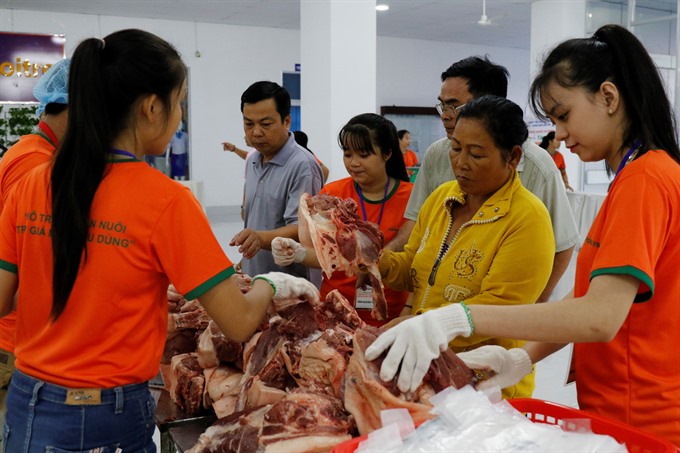 Economy
Economy

" />Pork prices have risen recently following programmes to stimulate demand and to control the number of pigs raised by farmers, according to the Ministry of Agriculture and Rural Development.
 |
| Consumers buy pork from a programme recently created to stimulate domestic consumption. — Photo courtesy of VTV-CORP |
HCM CITY — Pork prices have risen recently following programmes to stimulate demand and to control the number of pigs raised by farmers, according to the Ministry of Agriculture and Rural Development.
Nguyễn Xuân Dương, deputy head of the ministry’s Department of Livestock Production, said that a rise in exports to other countries, especially China, had helped raise prices.
As of today, pork prices are from VNĐ40,000 to VNĐ49,000 (US$1.8-$2.1) per kilo, increasing from VNĐ25,000 per kilo of the last three months.
According to a representative of C.P. Việt Nam Corporation, which raises pigs, the pork price rose to VNĐ41,500 per kilo today.
Nguyễn Kim Đoán, deputy chairman of Đồng Nai Province Livestock Production Association, said that more and more traders were visiting farmers to buy pigs, but many farmers did not want to sell as they were waiting for higher prices.
Hoàng Thị Liên, a pig-breeding farmer in the southeastern province of Đồng Nai, said that traders offered to pay VNĐ44,000 per kilo but she had decided to sell at a later date.
Deputy Minister of Industry and Trade Đỗ Thắng Hải said that this was a positive sign for farmers.
Hải, however, was concerned that the farmers might raise more pigs because of the rising prices.
The increase in growing pigs was one of the factors that contributed to low prices, according to Hải.
Huỳnh Thành Vinh, head of the Đồng Nai Province’s Department of Agriculture and Rural Development, said that farmers’dependence on the Chinese market to sell pork presented price risks.
The province is now focusing on reducing the number of pigs raised at small-size farms.
Quách Văn Tây, head of Livestock Production and Animal Husbandry Division in Sóc Trăng Province, said farmers should carefully study market information and warnings from agricultural agencies.
They also should meet with local authorities to receive counselling about breeding practices.
Dương of the Department of Livestock Production said that the farmers should focus on disease control, provide vaccines for pigs, and disinfect farms.
State management agencies and enterprises will continue to enhance domestic and foreign consumption, he added.
He recommended the restructuring of breeding and livestock production by using co-operative chains, and diversifying livestock products to meet demand.
The Đồng Nai Province Department of Industry and Trade reported that the province’s total number of pigs was 1.6 million, a drop of 500,000 compared to the last three months.
Lục Văn Thủy, head of the department’s commerce division, told Tuổi Trẻ (Youth) newspaper that the province’s pork market was now stable.
Phan Ngọc Châu, head of the Livestock Production and Animal Husbandry Division in Long An Province, said that reduced prices in the last three months had led to a decrease in the number of pigs in the province from 280,000 to 230,000.
Nguyễn Văn Đồng, head of Hậu Giang Province’s Department of Agriculture and Rural Development, said the province would focus on raising 12,000 breeding pigs to prepare for the market when it recovers. — VNS




